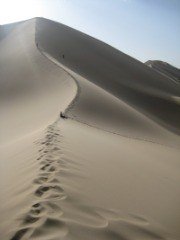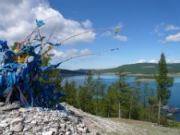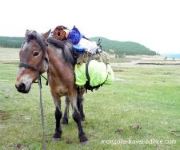|
Mongolia horse treks: my tips, pictures, and advice to plan your trip
Where do you want to ride? Lake Khovsgol region, Terelj National Park near Ulan Bator, and the Altai Mountains in Western Mongolia are scenic, popular destinations. Karakorum in central Mongolia is also a good place to organize a custom Mongolia horse trek. These places have operators equipped to handle tourists, so are the easiest places to organize a trip from. Otherwise, horses are everywhere and you can start wherever you like if you have the time, patience, and a Mongolian-speaker. Horse riding in Mongolia won't cost you much, it's far cheaper than hiring a vehicle. You can typically rent a horse for $20 a day or less. Allow for renting another pack horse (supports 3 people) if you're going on an overnight ride. A guide will cost you about $20/day also; it's worth asking if the guide speaks English, the many who don't will generally cost you less. If buying a horse, bank on at least $300; it'll likely sell for less than half that when you leave. If you have a (trusted!) local, consider hiding away and have them sell it for you: rich Westerner leaving country tomorrow = bad price. How much time to spend on a Mongolia horse trek is really up to you. Riding is rewarding but not always comfortable -particularly on the local saddles. If you haven't ridden on long journeys before, and like more of the comforts in life, then be conservative: book a brief ride or an overnight ride -you can always extend or do another ride if you enjoy it. Places like Terelj and the South-West shore of Lake Khovsgol have enough tourist facilities that you could plan to find a warm yurt and even some hot showers each night. This, plus the option of kicking your feet up and having a break for a day, might encourage some to take a longer trip. A four day horseback ride is a good amount of time for most tourists, before the saddle sores, heat, and biting flies start to take their toll. But any trip more than 4 days or so will become a real adventure, 12 days can get you to little-visited places such as the Tsagaan Nuur near Khovsgol, and a surprising number of people plan a journey of 2 months or more! Back to Top 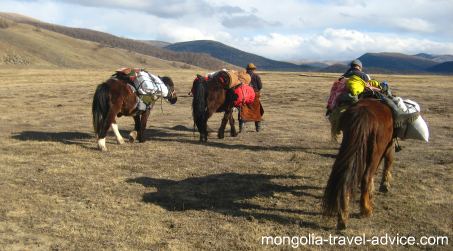
Who to go with? Many people band together with other travelers on a Mongolia horse trek for some company and to split the cost of a pack horse and guide. Some tourists have a romantic notion about riding off alone into the sunset, but even with a non-English speaking guide, 5 nights of silence around the camp fire might start to feel pretty lonely! You really aren't short of open space in Mongolia, so there is plenty of opportunity to spread out hundreds of meters apart to have your private moments of contemplation/ solitude/ conversion to Buddhism. If you're not an advanced rider, you should consider a guide essential. 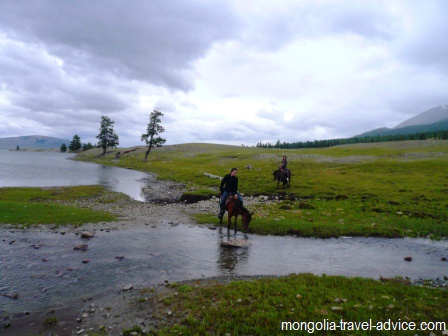
Travelers have reported horse thefts in the night; this is far less likely to happen if you have a guide. Theft could potentially leave you stranded in a remote place, and I don't know of many good horse insurance policies. Guides also know the best trails, and where the water is. If you're planning a solo trip in Central Mongolia or the Eastern Steppe (Gobi desert is more camel country, don't think about going it alone there) then finding water each day will be critical: try to follow a river if there is one. Remember: yurts mean drinking wells. Also, if you're not an expert rider, consider taking some lessons back home before you leave on your Mongolia horse trek. Back to Top 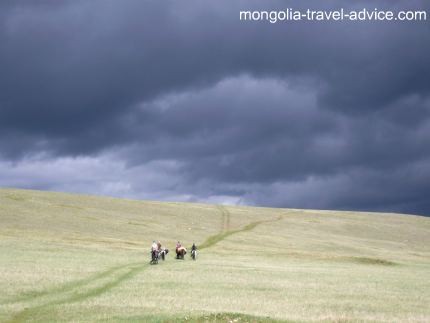
Mongolian horses are tough. To survive those winters, they'd have to be! The warriors of Genghis Khan conquered such an empire partly because their horses could ride further, with less food and water, than other horses. They're quite short compared to other horses, but never call them ponies: it can be insulting to a Mongolian man to ridicule the size of his horse. Copyright Mongolia-travel-advice.com Imagine, the same horse blood you're riding on helped lead the Mongols into fierce battle. Unfortunately, such equine bravery can translate into stubbornness as far as the modern-day tourist is concerned. They're generally a hard-mouthed bunch, and not always inclined to start moving when requested. They're canny and will quickly figure out who's boss: you need to show them from the outset that failure to move will mean a decent kick, and stopping to feed at their leisure will bring a tug on the reins. Mongolian horses are left half wild in the winters; this makes them a bit unpredictable, so be careful when you have a new animal on any Mongolia horse trek. Each horse has its own personality, and once you figure out each other then your relationship will become something deep, meaningful, and mutually rewarding. If you're having serious relationship trouble then your Mongolian guide will be more than happy to provide some counselling; this typically involves taking a stick and slapping the horse so hard it springs off into a gallop -with you holding on for dear life. Back to Top 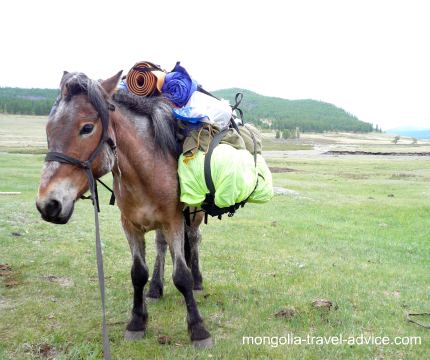
Saddles come in two varieties: painful, and excruciating. The painful, Russian saddles effectively involve a thin cushion fixed over a wood and steel frame which sits on the horse's back. More a medieval torture instrument than a seat, the excruciating Mongolian saddles are pure wood, with a leather lining if you're lucky, and often have a decorated steel bevel just to rub into the inside of your thigh. I'd find it unthinkable to do a Mongolia horse trek on one of these. Unless you have a butt lined with titanium like a Mongolian, stick with the Russian variety -no foreigner is expected to do otherwise. I've found the uncomfortable Russian saddles to be the only bad thing about Mongolia horse treks. People say that after 3 days of horse riding you'll become accustomed and the pain will abate… but in my experience it just gets worse every day. Those considering a serious journey should consider taking a saddle from home; I'm not aware of anywhere you can buy western saddles in UB. For me, I love long horse rides, I don't want to cart my own saddle around, and the discomfort is well worth putting up with. Back to Top Mongolian riding style is quite similar to the style of the American West -not surprising, as both were developed for handling stock and riding over long distances. Neck reins are held with the poor hand only, leaving the good hand free to carry a rope, whip, or bow as the case may be. You gently pull the reins the side you want to go, the reins will pressure the horse's neck on the opposite side and away he'll turn. Mongolians also don't post (rise) to the trot ('jog', to Americans), they stay seated which is easier riding long distances. Mongolians are willing to work -and hit- their horses so hard it makes some Westerners squirm; horses are deeply loved but are seen as utilities to be worked and driven, not simply cute animals for novelty rides. That's just the way it is. On the bright side, the mere act of breaking off a tree branch or carrying along a stick on a Mongolia horse trek will see a slow horse speed up without you even having to use it (or you might find you have to use it hard to get the horse to do anything for you). Back to Top 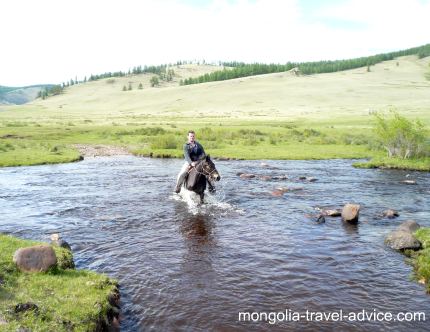
Riding tips and basics Most Mongolians start in the saddle before they can barely walk. I've seen toddlers lead a horse up to a ger or post, climb up and onto the horse, and then go cantering off bareback without a care in the world. Against such effortless mastery, you'll likely look a complete buffoon and attract the odd laugh when horseback riding in Mongolia, just maintain a good sense of humour and enjoy yourself. I am not an expert, but have spent a fair bit of time on horseback over the years. Following the below tips should stand you in good stead when horse riding in Mongolia; you might even get laughed at less:
Back to Top 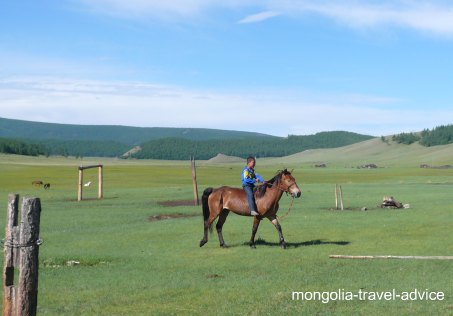
As a first step, ensure you read my what to pack page to cover off general clothes and gear for your trip. Added to this, there are a few specialised items you may want to consider for a Mongolia horse trek:
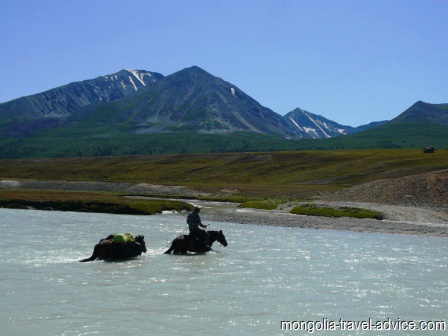
If you are an advanced rider, make sure you ask your tour operator to convey to the guides that you want a good horse: if you're a confident rider, it can be frustrating to be stuck with some old nag for a week. Back to Top 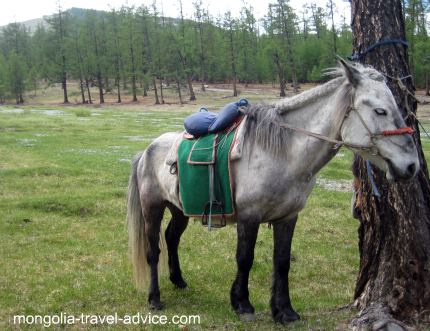
Organizing a Mongolia Horse Trek can be difficult to do directly unless you're in the country. Most of the Mongolia horse trek operators live in isolated areas and it's difficult to contact them before you arrive (e.g. modern communications in Khatgal and Terelj are disruptive and unreliable at best). Furthermore, many of them don't actually speak English. In my experience, your best bet if you want to organisze a Mongolia horse trek remotely is to go through a reputable tourist operator in Ulan Bator, or a Kazakh tour operator if you want to go way out West and do your Mongolia horse trek in the spectacular Altai mountains. A company like Bek Travel can organize a professional and well-priced tour to Central Mongolia, including (cheaper) group tours as well as custom tours if you want to go with your own group. They also can get you to some more remote areas, such as an all-inclusive 12-day horseback ride to the Reindeer people (Tsataan) in the rugged and remote areas north west of Lake Khovsgol.You can send an inquiry to them using the form below.
|
